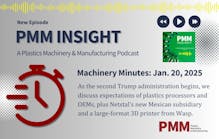SlicEx This new slicing software, developed through a partnership between software developer Create It Real, Aalborg, Denmark, and Aim3D, makes use of a cross-layer filling strategy to overcome uneven strength values produced by the build-up processes currently used by extrusion filament- and pellet-based printers. It’s designed for Aim3D’s ExAM 255 and ExAM 510 printers, which perform Composite Extrusion Modeling (CEM) 3D printing, a pellet-based Fused Granulate Modeling (FGM) extrusion process that combines injection molding with the ability to debind and sinter. The printers can handle plastic injection molding pellets, as well as metal and ceramic materials, and hybrid components. Due to the automatic generation of support material, they can be used to produce complex shapes. They are appropriate for a wide range of applications from prototyping to medium-sized production volumes of as many 100,000 parts a year. With SlicEx, the printing process proceeds in stages: The CEM system creates a lattice up to a defined height of the volume, then fills previously created cavities, called voxels, through extrusion. This so-called Voxelfill process allows some cavities to go unfilled — as long as doing so does not compromise strength.
What’s new? The plug-in, along with a related plug-in, Voxelfill, that’s capable of working with all extrusion filament- and pellet-based additive manufacturing (AM) processes and will be commercially available by the middle of next year.
Benefits The ability to overcome inhomogeneous strengths and to achieve selective densities of 3D plastic components, enhancing the cost-effectiveness of the CEM process. Such inhomogeneity can lead to tensile and flexural strength shortcomings, as well as brittleness. By allowing for printing in lattices, rather than by layers, SlicEx makes possible stronger parts. Aim3D anticipates that at some point, SlicEx will help users achieved improve Z-axis strength and printing speed.
New Aim3D GmbH, Rostock, Germany, 49-381-36766090, www.aim3d.de/en
Vital Statistics
|
Printer |
Size |
Build space |
Heating plate temperature |
Maximum extrusion temperature |
|
ExAM 255 |
6 feet by 3.4 feet by 2.4 feet |
10 inches by 10 inches by 10 inches |
320 degrees Fahrenheit |
752 degrees Fahrenheit |
|
ExAM 510 |
6.6 feet by 7.1 feet by 5.4 feet |
20.1 inches by 20.1 inches by 16.1 inches |
527 degrees Fahrenheit |
752 degrees Fahrenheit
|
Karen Hanna | Senior Staff Reporter
Senior Staff Reporter Karen Hanna covers injection molding, molds and tooling, processors, workforce and other topics, and writes features including In Other Words and Problem Solved for Plastics Machinery & Manufacturing, Plastics Recycling and The Journal of Blow Molding. She has more than 15 years of experience in daily and magazine journalism.






